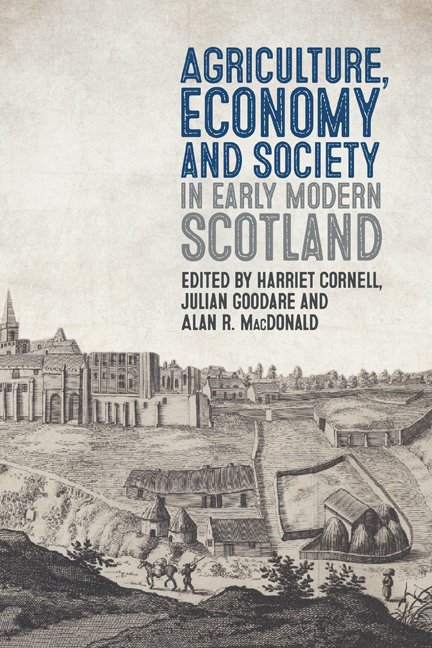Book contents
- Frontmatter
- Dedication
- Contents
- Illustrations
- Contributors
- Acknowledgements
- Note on Currency and Measures
- Abbreviations
- Map of Scotland
- Introduction: Exploring Scotland’s Agricultural History
- 1 Imagining Scottish Agriculture before the Improvers
- 2 The Use of Dykes in Scottish Farming 1500–1700
- 3 The Famine of 1622–23 in Scotland
- 4 Weather and Farming through the Eyes of a Sixteenth-Century Highland Peasant
- 5 Stock, Fermes, Mails and Duties in a Midlothian Barony 1587–89
- 6 The Roots of Improvement: Early Seventeenth-Century Agriculture on the Mains of Dundas, Linlithgowshire
- 7 ‘God Knowis my Sleipis ar Short and Unsound’: Andro Smyth’s Collection of Rent, Tax, Teind and Tolls in Shetland c.1640
- 8 Farming in the Stirling Area 1560–1750
- 9 What Were the Fiars Prices Used For?
- 10 Agriculture and Banking in Eighteenth-Century Scotland 1695–1750
- 11 Capitalism’s Cradle? Ideas, Policies and the Rise of the Scottish Economy in the Mercantilist Age 1600–1800
- Conclusion: A Historiographical and Bibliographical Overview
- Index
- Boydell Studies in Rural History
8 - Farming in the Stirling Area 1560–1750
Published online by Cambridge University Press: 14 May 2024
- Frontmatter
- Dedication
- Contents
- Illustrations
- Contributors
- Acknowledgements
- Note on Currency and Measures
- Abbreviations
- Map of Scotland
- Introduction: Exploring Scotland’s Agricultural History
- 1 Imagining Scottish Agriculture before the Improvers
- 2 The Use of Dykes in Scottish Farming 1500–1700
- 3 The Famine of 1622–23 in Scotland
- 4 Weather and Farming through the Eyes of a Sixteenth-Century Highland Peasant
- 5 Stock, Fermes, Mails and Duties in a Midlothian Barony 1587–89
- 6 The Roots of Improvement: Early Seventeenth-Century Agriculture on the Mains of Dundas, Linlithgowshire
- 7 ‘God Knowis my Sleipis ar Short and Unsound’: Andro Smyth’s Collection of Rent, Tax, Teind and Tolls in Shetland c.1640
- 8 Farming in the Stirling Area 1560–1750
- 9 What Were the Fiars Prices Used For?
- 10 Agriculture and Banking in Eighteenth-Century Scotland 1695–1750
- 11 Capitalism’s Cradle? Ideas, Policies and the Rise of the Scottish Economy in the Mercantilist Age 1600–1800
- Conclusion: A Historiographical and Bibliographical Overview
- Index
- Boydell Studies in Rural History
Summary
This chapter examines farming in the old counties of Stirling and Clackmannan with some contiguous areas of Perthshire but excluding the Highland area around Ben Lomond. It includes the carselands of the Forth Valley, the Ochils and parts of the Fintry Hills. Variations in ecology throughout this region, compounded by differences in tenure, communications, capitalisation and other human factors, contributed to a wide range of farming economies. Change accelerated in all zones in the 1750s but was certainly not new. Whilst recognising that there were many barriers to change – including climate and warfare – the emphasis here is on specific and local changes and the impediments hindering decisive transformation. We are rightly warned against using the ‘argument from example’ to overstate the changes before 1750. So this chapter asks: ‘What were the signs of change before 1750?’ The answers suggest that we also need to avoid dismissing earlier changes as merely preparatory for ‘real’ change later.
* * *
Contemporaries divided the region into carse, dryfield and muir. The carse – below about 30m, beside the River Forth – and the dryfield (between carse and muir) were the main arable zones. Above 100m or so was primarily pastoral, though arable was found to c.350m. ‘The Crucks of the Forth are worth an Earldom in the North’, was a ‘Common saying’ in 1706, underlining the fertility of the eastern carselands. But the carse clay had some sandier areas, some wet meadows and areas of raised peat bog and salt grass. West of Stirling, with higher rainfall and later harvests, very similar soils produced lower-quality grains, and there was more emphasis on dairying. The dryfield soils varied from sandy to heavy clays, and were also of very variable aspect and slope. There were bogs and woodlands, and the zone was intersected by streams. Perhaps half the dryfield was pasture, rocks or braes, or covered with whins (gorse) or broom. The hill pastures were also a mosaic. For example, Sheriffmuir provided common grazing for the farms of Strathallan but also peat, turf, limestone, heather and rushes for thatch, essential resources for farms on the lower ground. Above the head dykes of the muir, herds named around forty features – peat workings, lime kilns, standing stones, streams; and the head dykes were themselves being pushed up, onto former muir, before 1750.
- Type
- Chapter
- Information
- Agriculture, Economy and Society in Early Modern Scotland , pp. 176 - 198Publisher: Boydell & BrewerPrint publication year: 2024



